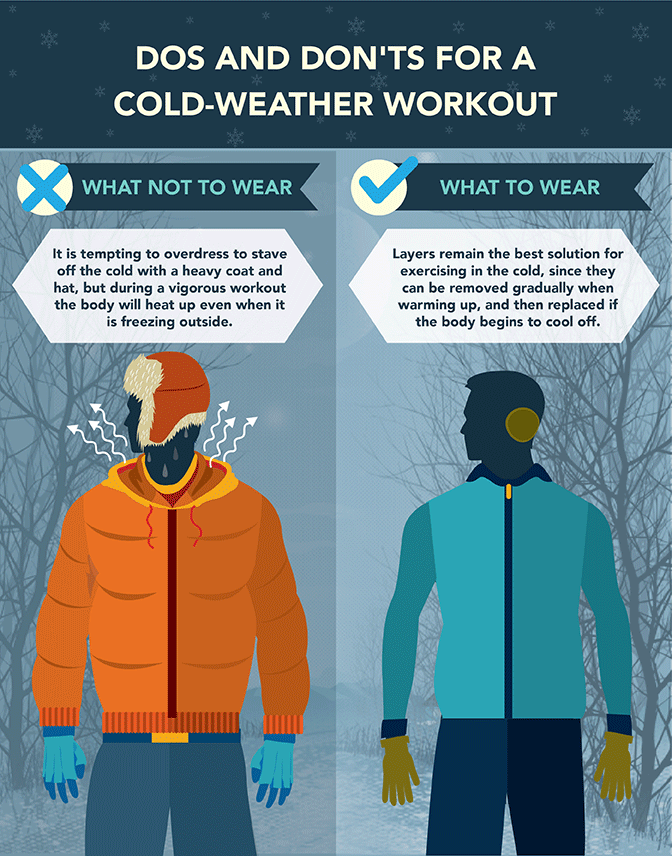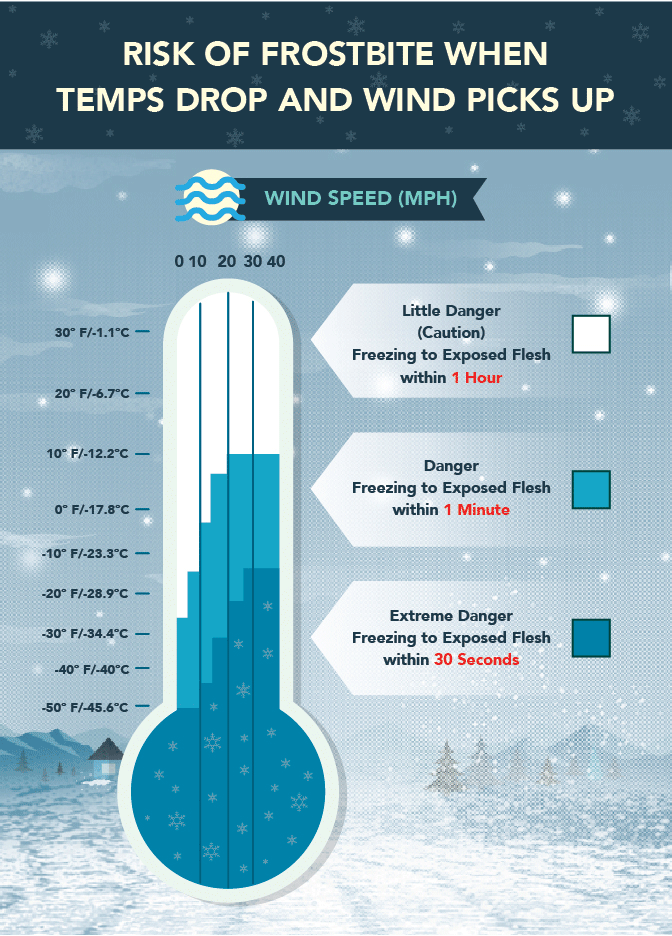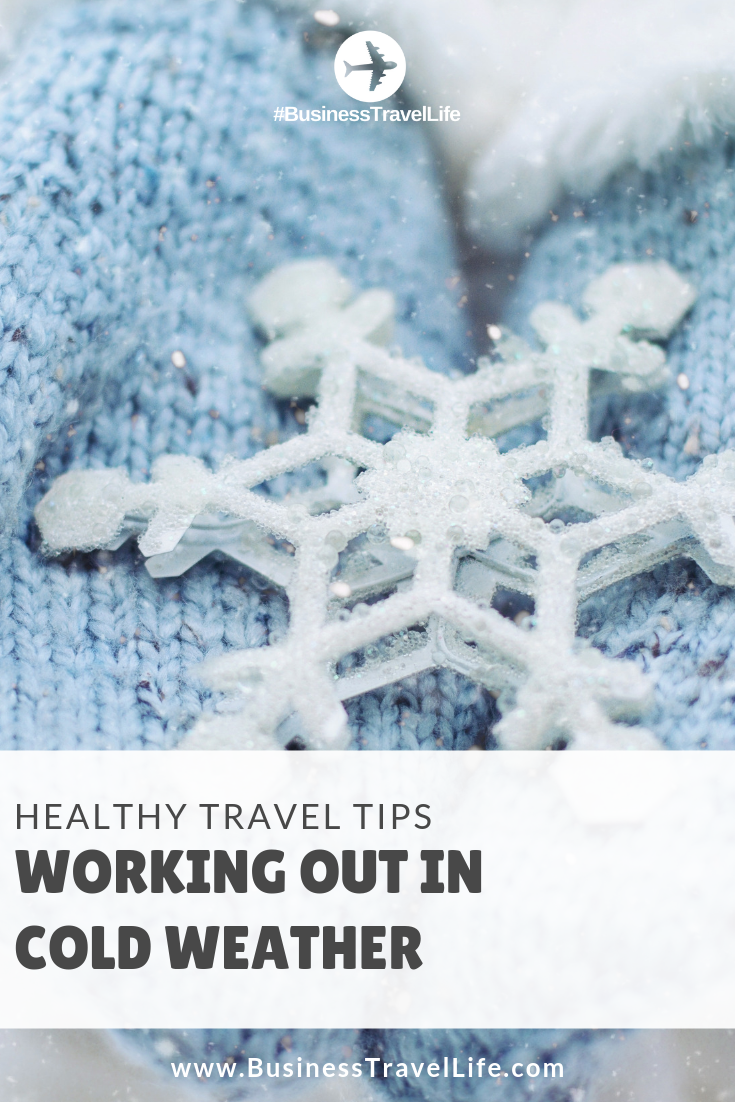Running is an excellent way to stay in shape while you travel. If running is your preferred hotel workout, be sure to read this article written by Annabel Fitzsimmons with great cold weather running tips.
Heating Up in the Cold
Workout Safety for Cooler Temps
When the temperature plummets, the thought of heading outside to exercise can be daunting, but there’s no need to stay cooped up inside. Cold-weather workouts can be some of the most challenging and rewarding exercise sessions. Aside from the physical benefits, research shows that exercising outdoors can increase energy, decrease depression, lessen anxiety, and enhance mood.12
There are risks associated with cold-weather workouts, just as there are risks when exercising in the heat. But with the right gear and know-how, outdoor workouts can be safe, injury-free, and enjoyable when the temperature drops.
Bundle Up: What to Wear
The first step to prepare for winter workouts is to gather the right clothing. It is tempting to overdress to stave off the cold, but during a vigorous workout, the body will heat up even when it is freezing outside.3 Layers remain the best solution for exercising in the cold since they can be removed gradually when warming up and replaced if the body begins to cool off.
Source: Fix.com
For the layer closest to the body, it’s important to wear clothes with sweat-wicking properties that will draw moisture away from the skin. The next layer should act as insulation; fleece or wool is ideal to hold in heat. For the outer layer, look for waterproof and wind-resistant garments that also offer breathability.
The core tends to remain warm while exercising outside, leaving extremities (ears, cheeks, nose, and hands) more susceptible to the cold. Gloves – or, in extreme cold, liner gloves with mitts as an outer layer – will protect the hands. Coverings for the head, neck, and face vary depending on the conditions outside. If the wind chill is low, or if an activity is fast-paced, such as skiing, bring a facemask, goggles, and a neck warmer. If the weather is milder, a headband or a hat that covers the ears should be sufficient.
The feet are also susceptible to the cold, especially in slushy, snowy, or wet conditions. Keep feet warm and dry with moisture-wicking or thermal socks and waterproof footwear.
Cold-Weather Risks: What to Look Out For
Overexertion
Exercising in the cold requires more effort. The heart has to work harder, and winter conditions (think snow, ice, and slush) are more taxing on certain muscle groups than regular dry-land training. Be sensitive to your body, know the signs of overexertion, and tailor workouts accordingly. Allow for a longer warm-up so the body can acclimatize – and literally warm up – to cooler temperatures. Focus more on the quality of the workout than on the quantity.
Heart safety
Know your fitness level. If you are out of shape and not used to regular workouts in moderate weather, be extra careful when exercising in a colder climate. Sudden strenuous physical activity in extreme winter weather puts people at increased risk of a heart attack, especially if they are not in good physical condition.4 For example, in the case of a ski vacation, do not spend 10 hours on the slopes on the first day if regular exercise isn’t a part of your daily routine. Begin the holiday with measured amounts of skiing and gradually build on more time and intensity from there. If you have any pre-existing medical conditions, be sure to check with your doctor before starting a winter exercise program.
Frostbite
Frostbite occurs when the skin freezes. The hands, nose, cheeks, and ears are most vulnerable to frostbite. As the wind chill drops, the risk of frostbite increases, so be aware of the weather conditions before heading out the door. When the temperature or wind chill falls below minus 18 degrees Fahrenheit, exposed skin can freeze in 30 minutes or less.5 Early warning signs of frostbite are redness, swelling, numbness, tingling, or a burning sensation. If you have already experienced frostbite on a part of your body, that area will be more prone to frostbite in the future.
Source: Fix.com
Hypothermia
Hypothermia occurs when the body temperature drops and the body loses heat faster than it can produce it.6 This can be caused by exposure to extreme cold for a long period – from getting wet in the cold or a sudden stop or slowing down of activity that prevents the body from keeping itself warm. Some warning signs of hypothermia include feeling dizzy or disoriented, extreme fatigue, and slurring of speech.
Luckily, most risks associated with exercising in the cold can be easily averted by wearing the appropriate clothing, assessing the weather conditions, and being attentive to the sensations of the body. If anything feels out of the ordinary, seek medical attention immediately.
Injuries
Uneven ground can be treacherous under ice or snow since snow can mask obstacles like tree roots. Snow also makes it difficult to detect slippery surfaces underfoot. To avoid injuries caused by slipping and falling, such as ankle sprains, choose routes and trails that are familiar, well maintained, and well travelled. If the ground is icy or slippery, adjust the pace as necessary. It’s better to take it slow and be safe than to be fast and risk a fall.
Cold Weather Exercise: The Must-Do List
Aside from being aware of the physical risks of cold weather workouts and having the right apparel, there are many other factors to consider when it comes to safety.
Take Advantage of Daylight
Train in the daylight so you can see your surroundings and safely navigate any tricky terrain. Exercising during the winter can be challenging enough in clear conditions. Adding the element of darkness to the mix is an avoidable danger. It is also warmer when the sun is up, so take advantage of daytime workouts whenever possible. The sun is still strong in winter, and snow is a natural reflector of the sun’s rays, so don’t forget sunscreen. Without protection, the skin can still burn.
Safety in the Dark
With shorter days, we often cannot avoid exercising in the dark. Consider the following safety tips for early morning or nighttime workouts.
Wear the Appropriate Gear
Whether running, skiing, or skating, wear the appropriate safety gear, and ensure that their quality is up to standard. In the case of skating or skiing, protect the head by wearing a helmet. For runs or hikes, choose footwear with good traction (either shoes with spikes on them or removable grips for shoes) to stay steady on slippery terrain.
Monitor Fluid Intake
It’s easy to forget to hydrate because cold weather depresses thirst.7 But dehydration can happen just as easily in cooler temps as it can in the heat. Approach fluid intake during a winter workout just like you would for a summer workout, especially if you’re exercising for longer than two hours. Be well hydrated before heading out to exercise, and aim to drink a liter of fluid per hour of vigorous exercise (or eight ounces every 15 minutes).8 A good marker for dehydration is urine. When you are well hydrated, your urine will be light in color or clear. If it is a dark or caramel color, that is a strong sign that you need to increase your fluid intake.
Find a Tribe
Work out with a buddy or in a group. There is power in numbers, both for physical safety and in case of something unexpected. Workout buddies are also great motivation to get out the door on those really cold days.
Stay Safe when Solo
If you’re exercising alone, consider carrying an alarm, and choose familiar routes that are well lit and frequented often. Keep the workout close to home so that, if conditions suddenly change, home base isn’t too far away. For example, if a long run is on the schedule, consider short loops instead of a longer out-and-back route. Finally, be sure to let someone know where you’ll be and when you’ll return.
Be Visible
Choose gear with reflective material to increase visibility in the dark. Clip a light to the back of a running belt or pants, or wear a headlamp during your workouts for extra visibility.
Create a Post-workout Protocol
Be concerned about the risks of extreme cold even after exercise. Once a workout is complete, get out of the cold as quickly as possible to keep your body temperature from dropping. Remove any wet clothing and replace with a dry layer. If it’s necessary to stay outside after a workout, bring along additional warm clothing to put on over your workout gear.
Source: Fix.com
Exercising in the winter requires more thinking and planning, but it is a step up from being stuck indoors during the colder months. Take advantage of all nature has to offer – just make sure to stay safe and know your limits. If the weather conditions are too extreme, make the call to take your workout inside.
Sources:
- http://www.ncbi.nlm.nih.gov/pubmed/21291246
- http://www.thestar.com/life/health_wellness/2013/08/06/the_benefits_of_taking_your_workout_outdoors_go_beyond_fitness.html
- http://www.ucdenver.edu/academics/colleges/medicine/sportsmed/cusm_patient_resources/Documents/Workout%20Tips%20for%20Exercise%20in%20the%20Cold.pdf
- http://www.texasheart.org/HIC/Topics/HSmart/exercis1.cfm
- http://www.mayoclinic.org/healthy-living/fitness/in-depth/fitness/art-20045626
- http://www.mayoclinic.org/healthy-living/fitness/in-depth/fitness/art-20045626
- http://www.unh.edu/news/news_releases/2005/january/sk_050128cold.html
- http://sirc.ca/sites/default/files/content/docs/newsletters/archive/mid-jan08/feat3.cfm
Business Travel Life is an online resource supporting the road warrior lifestyle. We give business travelers the tools they need to maintain their wellness and productivity when traveling. The topics we cover include business travel tips, travel workouts, healthy travel hacks, travel products, general travel tips, and industry trends. Our goal is to make business travel a healthier experience – and to make healthy travel practices more accessible to all road warriors.




